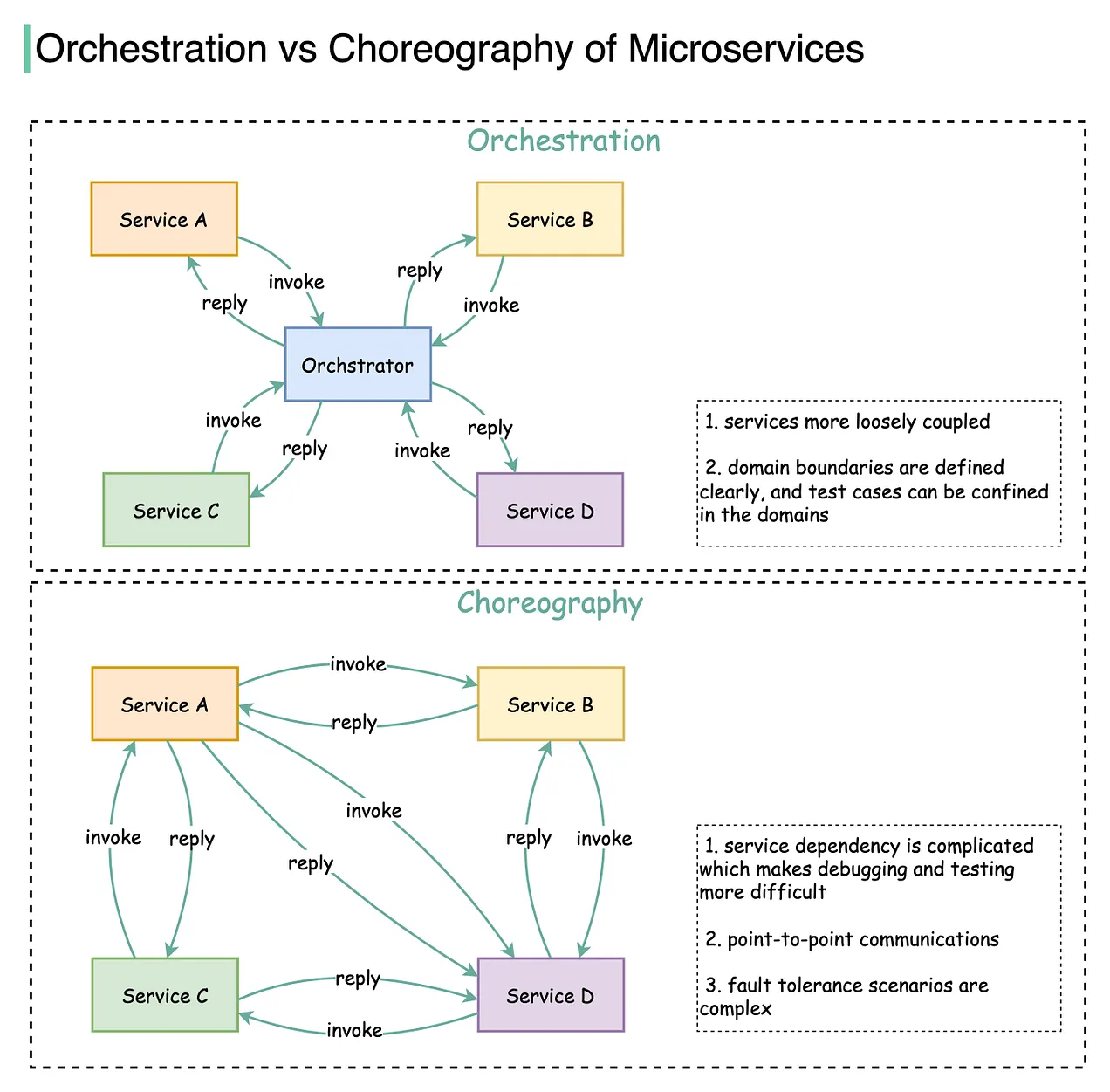link: Microservices Architecture
Orchestration and Choreography
Diagram

Overview
Orchestration and Choreography are two fundamental approaches to managing interactions and workflows between microservices in a distributed system. Each approach has its advantages and use cases, depending on the complexity and requirements of the system being developed.
Orchestration
Orchestration involves a central controller, known as the orchestrator, that manages and coordinates the interactions between different services. The orchestrator directs the workflow and ensures that each service performs its designated tasks in a predefined sequence.
Orchestration Characteristics
- Centralized Control: A central orchestrator controls the workflow, making it easier to manage complex business processes.
- Clear Visibility: The orchestrator provides a clear view of the workflow and its current state, simplifying monitoring and debugging.
- Error Handling: Centralized error handling is more straightforward, as the orchestrator can manage retries and compensations.
- Examples: Tools like Apache Airflow, AWS Step Functions, and BPMN (Business Process Model and Notation) are commonly used for orchestration.
When to Use Orchestration
- Complex Workflows: When the business process involves complex sequences of tasks with clear dependencies.
- Centralized Error Handling: When a central point for error detection and recovery is beneficial.
- Simplified Monitoring: When having a single point of control helps in monitoring and debugging the system.
Choreography
Choreography involves a decentralized approach where each service works independently, interacting with other services through events. Each service knows how to respond to specific events and trigger subsequent events without a central controller.
Choreography Characteristics
- Decentralized Control: No central controller; services communicate directly with each other through events.
- Scalability: Easier to scale, as there is no single point of failure or bottleneck.
- Loose Coupling: Services are loosely coupled, reducing dependencies and increasing flexibility.
- Examples: Event-driven architectures using message brokers like Apache Kafka, RabbitMQ, or AWS SNS/SQS are typical implementations of choreography.
When to Use Choreography
- Simple Interactions: When the interactions between services are relatively simple and can be handled by events.
- Scalability: When the system needs to handle high loads with ease of scaling.
- Decentralized Error Handling: When services can manage their own errors and compensations.
Comparison
| Parameter | Orchestration | Choreography |
|---|---|---|
| Control | Centralized | Decentralized |
| Workflow Management | Managed by an orchestrator | Managed by individual services through events |
| Visibility | High (single point of monitoring) | Lower (distributed monitoring) |
| Scalability | Can become a bottleneck | Highly scalable |
| Error Handling | Centralized error management | Decentralized error management |
| Coupling | Tighter coupling due to central control | Looser coupling, more flexibility |
| Examples | Apache Airflow, AWS Step Functions, BPMN | Apache Kafka, RabbitMQ, AWS SNS/SQS |
Summary
Summary
Understanding the differences between Orchestration and Choreography is crucial for designing effective microservice architectures. Orchestration offers centralized control and visibility, making it suitable for complex workflows, while Choreography provides decentralized, event-driven interactions ideal for scalable and loosely coupled systems. Selecting the right approach depends on the specific requirements and constraints of your project.
Related Topics
Summary
- Event-driven Architecture Pattern: Closely related to Choreography, where events trigger interactions between services, promoting loose coupling and scalability.
- Microservices Architecture Pattern: Both orchestration and choreography are key techniques for managing interactions and workflows in microservices-based systems.
- Service Mesh: A dedicated infrastructure layer that helps manage service-to-service communication, often used in conjunction with both orchestration and choreography for microservices.
- API Gateway: Manages and routes API requests between clients and services, often used in orchestrated systems to handle and direct traffic efficiently.